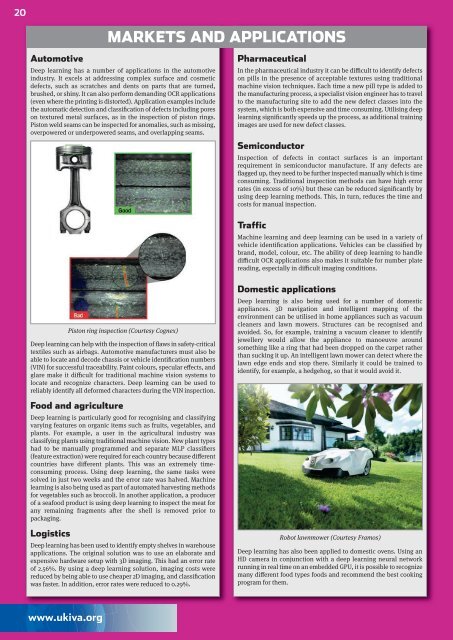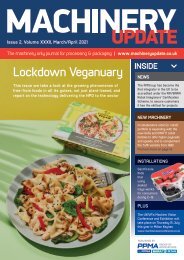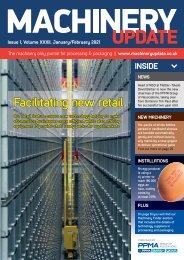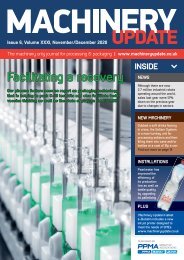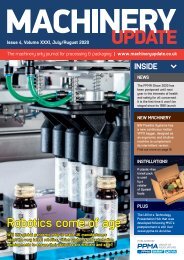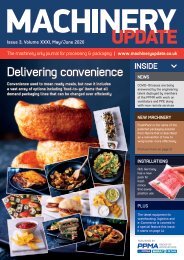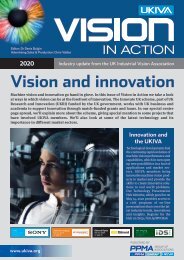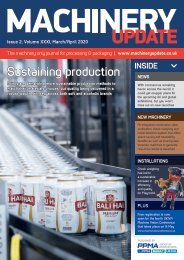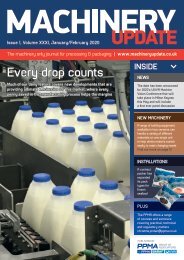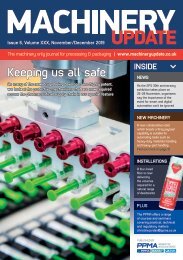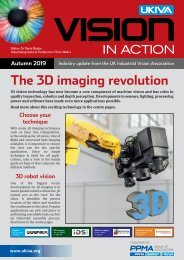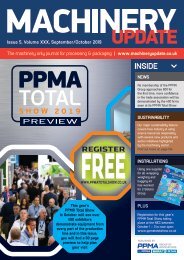VIA Autumn 2018 On-Line
Create successful ePaper yourself
Turn your PDF publications into a flip-book with our unique Google optimized e-Paper software.
20<br />
MARKETS AND APPLICATIONS<br />
Automotive<br />
Deep learning has a number of applications in the automotive<br />
industry. It excels at addressing complex surface and cosmetic<br />
defects, such as scratches and dents on parts that are turned,<br />
brushed, or shiny. It can also perform demanding OCR applications<br />
(even where the printing is distorted). Application examples include<br />
the automatic detection and classification of defects including pores<br />
on textured metal surfaces, as in the inspection of piston rings.<br />
Piston weld seams can be inspected for anomalies, such as missing,<br />
overpowered or underpowered seams, and overlapping seams.<br />
Pharmaceutical<br />
In the pharmaceutical industry it can be difficult to identify defects<br />
on pills in the presence of acceptable textures using traditional<br />
machine vision techniques. Each time a new pill type is added to<br />
the manufacturing process, a specialist vision engineer has to travel<br />
to the manufacturing site to add the new defect classes into the<br />
system, which is both expensive and time consuming. Utilising deep<br />
learning significantly speeds up the process, as additional training<br />
images are used for new defect classes.<br />
Semiconductor<br />
Inspection of defects in contact surfaces is an important<br />
requirement in semiconductor manufacture. If any defects are<br />
flagged up, they need to be further inspected manually which is time<br />
consuming. Traditional inspection methods can have high error<br />
rates (in excess of 10%) but these can be reduced significantly by<br />
using deep learning methods. This, in turn, reduces the time and<br />
costs for manual inspection.<br />
Traffic<br />
Machine learning and deep learning can be used in a variety of<br />
vehicle identification applications. Vehicles can be classified by<br />
brand, model, colour, etc. The ability of deep learning to handle<br />
difficult OCR applications also makes it suitable for number plate<br />
reading, especially in difficult imaging conditions.<br />
Deep learning can help with the inspection of flaws in safety-critical<br />
textiles such as airbags. Automotive manufacturers must also be<br />
able to locate and decode chassis or vehicle identification numbers<br />
(VIN) for successful traceability. Paint colours, specular effects, and<br />
glare make it difficult for traditional machine vision systems to<br />
locate and recognize characters. Deep learning can be used to<br />
reliably identify all deformed characters during the VIN inspection.<br />
Food and agriculture<br />
Deep learning is particularly good for recognising and classifying<br />
varying features on organic items such as fruits, vegetables, and<br />
plants. For example, a user in the agricultural industry was<br />
classifying plants using traditional machine vision. New plant types<br />
had to be manually programmed and separate MLP classifiers<br />
(feature extraction) were required for each country because different<br />
countries have different plants. This was an extremely timeconsuming<br />
process. Using deep learning, the same tasks were<br />
solved in just two weeks and the error rate was halved. Machine<br />
learning is also being used as part of automated harvesting methods<br />
for vegetables such as broccoli. In another application, a producer<br />
of a seafood product is using deep learning to inspect the meat for<br />
any remaining fragments after the shell is removed prior to<br />
packaging.<br />
Logistics<br />
Piston ring inspection (Courtesy Cognex)<br />
Deep learning has been used to identify empty shelves in warehouse<br />
applications. The original solution was to use an elaborate and<br />
expensive hardware setup with 3D imaging. This had an error rate<br />
of 2.56%. By using a deep learning solution, imaging costs were<br />
reduced by being able to use cheaper 2D imaging, and classification<br />
was faster. In addition, error rates were reduced to 0.29%.<br />
Domestic applications<br />
Deep learning is also being used for a number of domestic<br />
appliances. 3D navigation and intelligent mapping of the<br />
environment can be utilised in home appliances such as vacuum<br />
cleaners and lawn mowers. Structures can be recognised and<br />
avoided. So, for example, training a vacuum cleaner to identify<br />
jewellery would allow the appliance to manoeuvre around<br />
something like a ring that had been dropped on the carpet rather<br />
than sucking it up. An intelligent lawn mower can detect where the<br />
lawn edge ends and stop there. Similarly it could be trained to<br />
identify, for example, a hedgehog, so that it would avoid it.<br />
Robot lawnmower (Courtesy Framos)<br />
Deep learning has also been applied to domestic ovens. Using an<br />
HD camera in conjunction with a deep learning neural network<br />
running in real time on an embedded GPU, it is possible to recognize<br />
many different food types foods and recommend the best cooking<br />
program for them.<br />
www.ukiva.org


